Our Christmas is a very different occasion each year, from my Italian family to my English one with my wife and the grandparents. I’m very happy with whatever goes, and we’ve experimented with cooking different things at different times. I have great fondness for the Christmas lunches with Grandad and Grandma in Islington, where Grandad cooked a big piece of beef each year – it was fantastic when the kids were little. But when I think about the Christmases I had when I was young, there are many sweet memories.
When I was younger, my Christmas was very eclectic. All my family worked in restaurants, including on Christmas Day, and I did as well from quite a young age, doing Christmas lunch. Afterwards, we’d get together with our cousins, in different houses each year, and have a big Christmas dinner. It was a cornucopia – everyone contributed the dish they did best. It felt very joyous, and I never saw anybody stress about cooking.
Christmas is more than a lunch to me. When I choose a menu, even for the restaurant, I think about what is going to make people feel comfortable and settled.
It’s important to think about the amount of time and capacity you have to cook. If you’re stressed about your cooking, people are not going to enjoy it. To be natural about it, and to do the simplest things that you can produce, always works best. If you are relaxed about what is happening then your guests and family will be relaxed, and I think a good Christmas has a lot to do with that.
So when I chose the dishes for this menu, I thought about that and took inspiration from all my different Christmases. This is a bit of a compilation of my Christmas lunches from the past 57 years.
Russian salad with smoked salmon
In middle-class northern Italy, where I grew up in the 1960s and early 70s, there were two things you could not have Christmas without: smoked salmon and insalata russa. As an adult, I made Russian salad every year when I cooked, and sometimes when we went to the grandparents I would take it – because you have to have Russian salad on Christmas Day. Adding smoked salmon came much later, maybe only two years ago.
You can serve the salmon separately, but if you have the chance to get a length of it, cut it the same size as the vegetables and you get a very good effect by putting it through the salad.
Serves 6
desiree potatoes 3
carrots 3 medium, peeled
frozen peas 300g
hard-boiled eggs 4, peeled and diced finely
pickled gherkins 5, diced finely
mayonnaise 4 tbsp
sliced smoked salmon 600g
extra virgin olive oil to serve
Boil the potatoes for 30 minutes to start with, and then add the peeled carrots. Continue simmering for 10-15 more minutes, or until the potatoes and carrots are firm but tender when poked. Meanwhile, blanch the peas for 2 minutes in salted boiling water, drain and cool them down under cold running water.
When the potatoes and carrots are done, allow them to cool to the point that you can handle them easily. Peel the potatoes and dice them into 1cm cubes and put them into a medium serving bowl. Next, dice the carrots and toss them and the peas into the bowl with the potatoes, then add the diced eggs and gherkins. Stir the mayonnaise into the salad, binding everything together.
Cover the salad and chill for at least 1 hour or overnight to allow the flavours to come together. The next day, serve the salad in a serving dish with a plate of sliced smoked salmon seasoned with pepper and extra virgin olive oil on the side.
Radicchio and button mushroom salad, gorgonzola dressing
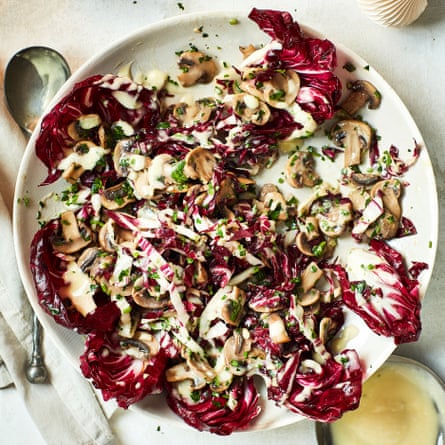
The bitterness of the radicchio with the sweetness of the mushrooms and the sharpness from the gorgonzola really gives a high, almost tingly, note in the mouth. You can prepare this recipe ahead of time, then finish and dress it at the last minute. You can serve it in different ways; scoop it into the radicchio leaves, so people can just pick them up. Make sure you give the mushrooms a bit of colour, be a bit aggressive. And don’t cook too many mushrooms at once; if you need to split the batch, do so – you want them to have more of a hard skin.
Serves 6
For the mushrooms
olive oil 1 tsp
garlic 1 clove, left whole
button mushrooms 600g, sliced
white wine ½ a glass
For the gorgonzola dressing
gorgonzola 30g
cream 1 tbsp
For the mayonnaise
English mustard 1 tsp
white vinegar 1 tbsp
egg yolk 1
vegetable oil 100ml
For the salad
garlic 2 cloves, chopped
parsley 1 small bunch
olive oil 2 tbsp
radicchio 2 heads, washed and set to one side
In a large frying pan, add 1 teaspoon of olive oil and the 1 garlic clove and cook for 1 minute until golden. Add the mushrooms, season with salt and pepper and cook for a couple more minutes till any liquid has evaporated, then add the white wine, let the alcohol evaporate and set aside.
In a small pot, melt the gorgonzola with the cream and pass through a fine sieve, then set aside. Next make the mayonnaise. Whisk the mustard, vinegar and egg yolk, slowly add the vegetable oil, and add the gorgonzola at the end. Check for seasoning.
On a chopping board, crush the 2 garlic cloves into a paste with the back of a knife, put the parsley on top, chop finely and set aside.
Select the bigger radicchio leaves, season with 2 tablespoons of olive oil and salt and pepper, and place them around the edge of a large serving dish. Finely slice the rest of the radicchio leaves, and in a separate bowl mix the mushrooms with the leaves, parsley, garlic and half of the dressing. Place the salad in the middle of the serving dish and finish with more dressing on the top.
Scialatielli or spaghetti with clams
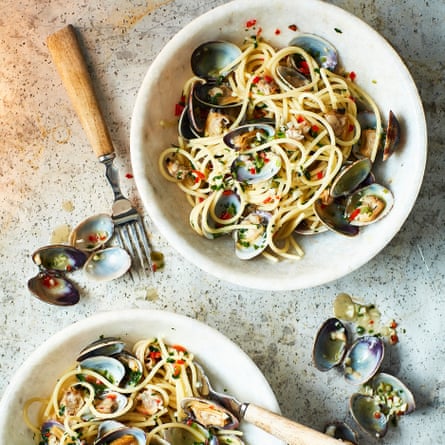
I’ve always had people from Naples in my kitchens, and when we do Christmas, they must have pasta with vongole. For the first few years after we opened our restaurant, we did Christmas with the staff in the restaurant and everybody had to contribute. We’d have people from different regions, so we’d say: “You have to cook a dish that you’d have at home.” The Neapolitans always wanted this.
I think if you want to make this dish, you should make the effort to make the scialatielli. Spaghetti will be absolutely fine, but scialatielli will be a little step up. It’s very easy to make yourself; go on YouTube, there are a couple of tutorials that work perfectly. It’s a very easy dough to make and you only need a knife to cut it.
I didn’t want to make this dinner too northern Italian. This screams Naples, and the beauty of the coast.
Serves 6
extra virgin olive oil 4 tbsp
garlic 4 cloves, finely chopped, plus 1 whole clove
mild green and red chillies 2, chopped
clams 1kg, cleaned
white wine 1 glass
parsley ½ a bunch
scialatielli or spaghetti 500g
In a large, deep frying pan, heat the olive oil. Add the chopped garlic and chilli, and cook over a moderately high heat, stirring occasionally, until the garlic is lightly browned. Add the clams and the wine, keep shuffling around the pan with the lid on until the clams open and are just cooked through, around 5 minutes.
With a slotted spoon, remove half of the clams and separate the clams from the shells, discarding any clams that do not open.
On a chopping board, crush 1 garlic clove to a paste with the back of a knife, put the parsley on top and finely chop.
Meanwhile, put a large pot of salted water on to boil. When it is boiling, add the pasta and cook for 2 minutes less than the cooking time. Drain it well.
Add the pasta to the clams and season with pepper. Toss over moderately high heat just until the scialatielli absorbs some of the juices and the sauce gets that silky consistency. Add the clean clams, and chopped parsley. Transfer the scialatielli and clams to shallow bowls and serve.
★ Wine match
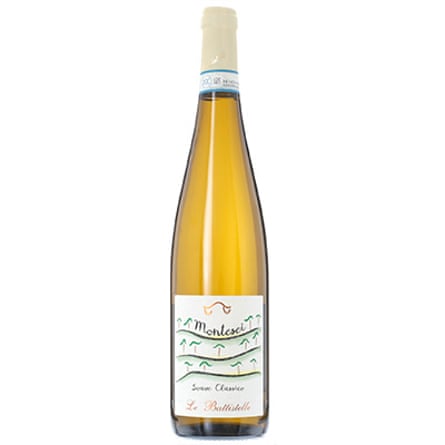
Le Battistelle Montesei Soave Classico, Italy 2019, £13.50, Lea & Sandeman
There’s just enough weight of juicy fresh pear and a lovely softness of texture for a hint of chilli heat here – but there’s also plenty of beguilingly easygoing acidity and freshness for the seafood. This is a charming example of modern soave that does the thing so many Italian whites do so well: flattering and enhancing a dish without overwhelming it.
Honey-glazed roast duck
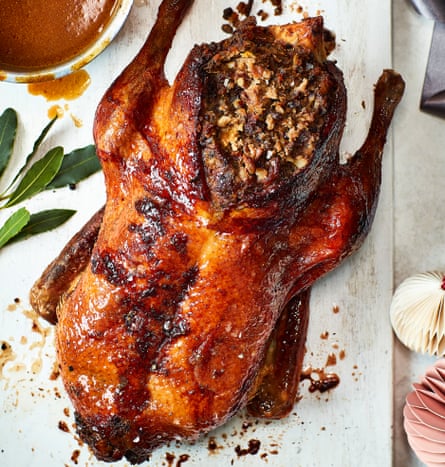
A few year ago, we had these huge Aylesbury ducks in the restaurant, and I went in the day before Christmas to pick them up. I didn’t realise until after I made it, that I put in all the same flavours as the stuffing my grandmother made during winter.
Chestnuts were very much in our life when I was little; we’d collect them and boil then dry them. We also had a fantastic apricot tree. Some of the fruit would be picked early and dried in the sun. We went mushroom hunting practically every day after school with my grandad, and in the autumn we’d dry the porcini. And then you have the usual bread and parmesan – very important; rosemary and sage, which were growing in our garden so they would be put into every stuffing. Finally, there’s no Christmas without a bottle of marsala.
Serves 6
duck 1 large (2.5kg)
carrot 1 large, chopped
celery 1 stalk, chopped
onion 1, chopped
garlic 2 cloves
fresh rosemary 1 sprig
bay leaf 1
white wine 200ml
hot chicken stock 2 litres
honey 2 tbsp
olive oil 4 tbsp
Worcestershire sauce 1 tbsp
For the stuffing
olive oil 2 tbsp
onion 1, finely chopped
duck or chicken livers 100g
marsala 70ml
pork sausage meat 400g
vacuum-packed chestnuts 100g, or fresh chestnuts, roasted and finely chopped
dried apricots 60g, soaked in water for 45-60 mins, then chopped into fingertip-size squares
dried porcini 50g, soaked in warm water for 3 hours, finely chopped
white bread 2 slices, soaked in just enough milk to soften
parmesan 2 tbsp, grated
egg 1
fresh rosemary and sage 1 tbsp, finely chopped
Preheat the oven to 160C fan/gas mark 4.
To make the stuffing, heat a little olive oil in a pan, add the onion and cook gently until soft and translucent, add the duck or chicken livers, season them, and cook until the livers start to caramelise. Add the marsala and let it bubble up – to evaporate the alcohol. Then lift out the livers on to a chopping board and chop finely. Leave to cool. In a large bowl, mix all of the rest of the ingredients for the stuffing and stir in the cooled duck livers.
Spoon the stuffing into the duck cavity and season it all over with salt and pepper. Place the duck on a roasting rack over a tray and cook for 20 minutes at 160C fan/gas mark 4 to drain the fat, then transfer the duck into a roasting tray with the chopped vegetables, adding a glass of wine and cook for another 80 minutes at 150C/gas mark 3½, pouring a ladleful of chicken stock over the vegetables every 15 minutes. Spoon 1 tablespoon of the honey over the duck and cook for another 10 minutes till the skin is golden and crispy.
Keep a little stock back in case you need it to thin the sauce later. To check that the duck is cooked, insert a skewer into the centre: it should come out hot and the juices should run clear. If you have a thermometer, the centre of the meat should be around 60C. Remove from the oven, lift the duck on to a large, hot serving plate, and leave to rest for 15 minutes.
Meanwhile, transfer the vegetables, herbs and the sauce that has been created from the wine, stock and duck juices into a blender and whizz to a sauce consistency, adding a little of the hot stock that you have kept back if it is too thick. Transfer the juice to a saucepan, bring to the boil, add the Worcestershire sauce and 1 tablespoon of the honey and check for seasoning. Spoon out the stuffing, slice the duck and serve with the sauce over the top.
★ Wine match
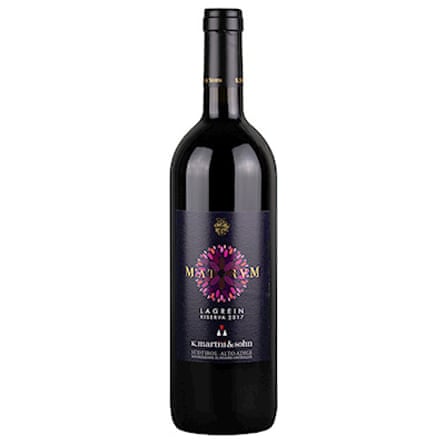
Maturum Lagrein Riserva, Alto Adige, Italy 2017, £29.90, Independent Wine
An elaborate recipe with a lot of flavours, richness and, this being duck, a certain amount of fat, calls for a wine with similar complexity and plenty of acidity. This Alpine red does both: a hit of vibrant black fruit, elegant floral notes, peppery spice, a hint of aniseed and great length.
Fennel gratin
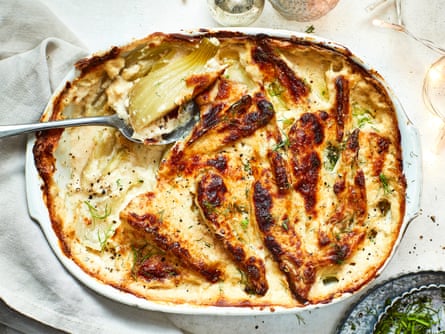
This is a very dear dish to me. It’s something my grandmother would make every Christmas – wherever the Christmas would be, she would bring it. By this time of year, it’s important to blanch the fennel because it will be big. If you don’t have parmesan, use another hard cheese.
It’s a very easy dish, and you can prepare it ahead of time, and as the meal goes on just stick it in the oven.
Serves 6
fennel 4 bulbs
milk 1½ litres
nutmeg 1 pinch
butter 90g
plain 00 flour 90g
parmesan 3 tbsp, grated
Preheat the oven to 180C fan/gas mark 6. Trim the tops from the fennel and cut each bulb in half through the root, then cut each half lengthways into three wedges. Boil the fennel in a large pan of salted water for about 5 minutes, till the fennel is just tender. Drain well and set aside.
Meanwhile, bring the milk to a boil with salt, pepper and nutmeg, then take off the heat. In a saucepan, melt the butter, add the flour and cook, stirring for a couple of minutes, then add the milk and keep whisking until it has thickened.
Place the fennel in a buttered ovenproof dish. Coat with the sauce, sprinkle with parmesan and bake for 25 minutes, or until the top is golden.
Turnip tops with garlic, chilli and almond

You can use any type of greens you have. If you use broccoli, I suggest you leave a little bit of the stalk on. It’s a very last-minute dish, although if you want, you can make it a bit ahead of time, and put the almonds on just before serving.
Serves 6
whole blanched almonds 220g
turnip tops 3 bunches, or 2 heads of broccoli separated into florets
fresh chillies 3 (2 red and 1 green), cut into fine strips
garlic 3 cloves, finely chopped
olive oil 4 tbsp
Preheat the oven to 160C fan/gas mark 4. Lay the almonds in a single layer on a baking tray and put into the oven for about 8 minutes. When they are golden, take them out and chop them.
Separate the turnip top leaves from the flowers. Bring a pan of salted water to the boil, put in the leaves, or broccoli, if using, and blanch for 1 minute, add the turnip flowers and cook for another minute, depending on the size of the florets. Drain in a colander.
Put the chilli and garlic with the olive oil into a pan and place on a medium heat until the garlic turns golden, then put in the greens and toss for a couple of minutes. Transfer to a serving dish and scatter with the toasted almonds.
Ricotta cake with chocolate and candied fruits
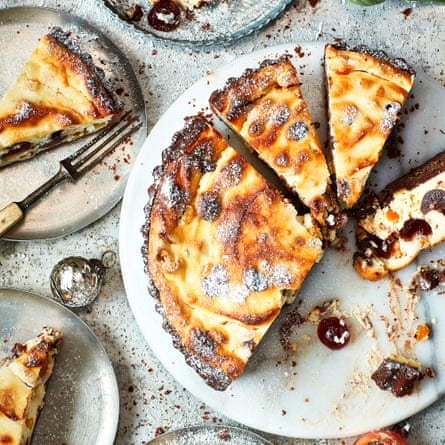
My parents owned a pastry shop, so there was never any problem deciding what would be for dessert. For me, it’s not Christmas without panettone, and I like to eat it in different ways. I made this last Christmas. It’s better if you bake it the day before and let it settle, the ricotta takes in all the flavours. Leave it overnight in the coolest place you have, but not the fridge.
The quantity of pastry given here is enough for two tarts, because it is much easier to work the pastry if you make it in bigger quantities. Freeze what you don’t need.
Serves 6
For the pastry
vanilla pod seeds from 1
unsalted butter 150g
caster sugar 85g
egg yolks 3
plain flour 250g
ground almonds 25g
cocoa powder 25g
For the pastry cream
milk 300ml
egg yolks 4, at room temperature
caster sugar 140g, plus extra for sprinkling
plain flour 30g
For the filling
fresh ricotta 450g
almonds 60g, chopped
lemon zest of 1
chocolate chips 50g
candied orange 30g
candied cherry 30g
candied lemon 30g
egg whites 5
caster sugar 75g
icing sugar to finish
To make the pastry, put the vanilla seeds, butter and sugar into a food mixer with a pastry paddle. Whizz for 3 minutes, until pale and creamy. While the motor is running, mix in the egg yolks, one by one, then add the flour, ground almonds and cocoa powder. As soon as it is all mixed, turn out the pastry, wrap in clingfilm, and leave in the fridge for about an hour to rest.
Preheat the oven to 160C fan/gas mark 4. Roll the pastry out into a circle about 5mm thick and use it to line a 20cm tart tin. Line with greaseproof paper, fill with baking beans, and bake for 5–7 minutes, until the pastry has dried out, but not coloured. Take out of the oven, remove the greaseproof paper and beans, and put to one side.
To make the pastry cream, warm the milk in a pan to just below simmering point, then take off the heat. In a bowl, whisk together the egg yolks, sugar and flour, then add to the warm milk and return to the heat, whisking continuously until the mixture thickens. Take the pan off the heat, leave to cool, then put through a fine sieve to make sure there are no lumps.
Add the ricotta, almonds, lemon zest, chocolate chips and candied fruit to the pastry cream. In a separate bowl, whip the egg whites with the sugar until they form peaks, then add to the mixture. Pour into the pastry case, sprinkle some sugar on top and put back into the oven for 25-35 minutes, until a sharp knife inserted into the centre comes out clean. Finish the cake with icing sugar.
★ Wine match
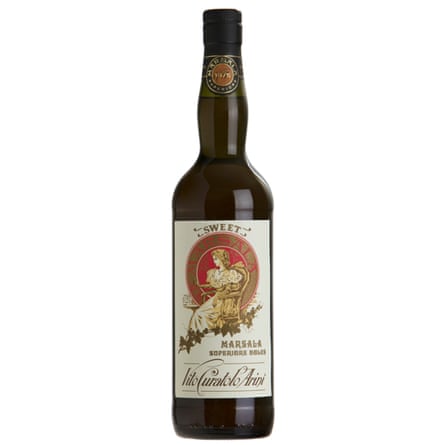
Curatolo Marsala Superiore Dolce, Sicily, Italy NV, £11.99, Waitrose
The historic Sicilian fortified wine is just the trick for this ricotta tart, with so many of the ingredients (almonds, chocolate, candied fruit) echoed in the glass.
Giorgio Locatelli is chef-owner of Locanda Locatelli, London
